Anna Geiger's Blog, page 34
March 18, 2020
What to do with your kindergartner when school is cancelled
Are you trying to figure out what to do with your kindergartner when you’re stuck at home due to school cancellations?
I’m here to help!
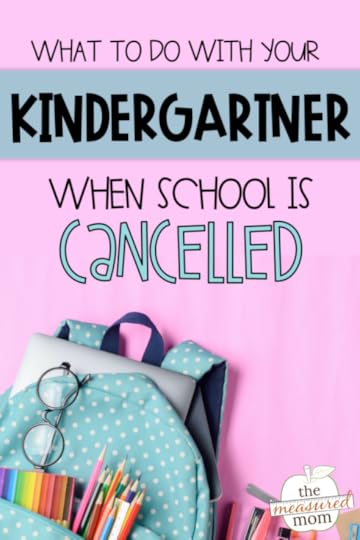
Isn’t it strange to feel a kinship with the rest of the world as we navigate school closings, social distancing, and (in some cases) self-quarantining?
As we seek to stop the spread of COVID-19, many of us find ourselves home with our kids without anywhere to go.
I’m one of those parents, as we have six kiddos (ages 4-12) at home for an indefinite period of time. This is very interesting, as there’s a good reason I am not a homeschooling mama. 
I put this together for myself (and my little kindergartner) as well as for you.
As you figure out how to fill the days with your child who is home from kindergarten, I hope this post helps!
What to do with your kindergartener
I recommend having a small portion every day when you do “school.” This does not need to be long, and you can break it into several sessions throughout the day. I recommend 60-90 minutes a day for kindergarten.
What you work on will depend on where your child is at developmentally.
Remember … 60-90 minutes a day is plenty! You can break it up into 2-3 sessions if needed.
A suggested schedule (you don’t need to do all of these every day, and please do take breaks instead of doing it all in a row):
20 minutes pre-reading or reading practice
15 minutes math
5-10 minutes handwriting
15 minutes writing
20 minutes+ of you reading to your child
*Only free resources are included in this post, but you are always welcome to check out my shop and online membership.
Pre-Reading
If your child is still learning letter sounds …
Focus on one letter at a time using these free letter sound cover pages.��
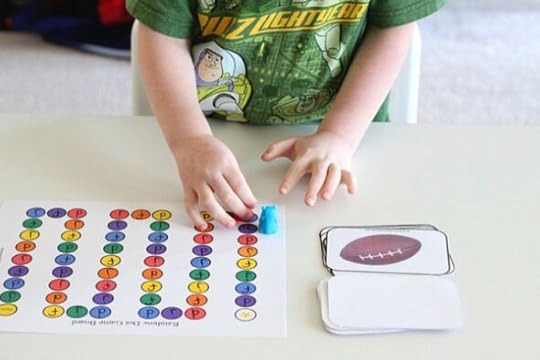
Create a simple game with letters whose sounds your child needs to work on ( here’s a free resource ).�� ��Include just a few letters at a time, and start with the easier sounds: /b/, /d/, /f/, /j/, /k/, /m/, /n/, /p/, /s/, /t/, /v/, and /z/. Move on to harder sounds: /c/, /g/, /h/, /q/, /l/, /r/, /w/, /x/, and /y/. Conclude with the short vowel sounds.
Practice RHYMING …
Here are some fun, low-prep rhyming printables on my site:
Rhyming matching game
Rhyming pinch cards
“I can rhyme” board game
Rhyming clip cards
Roll-a-Rhyme (this one is more advanced)
Build PHONEMIC AWARENESS …
Phonemic awareness is the ability to play with sounds in words. Start by watching this video to understand what phonemic awareness is.
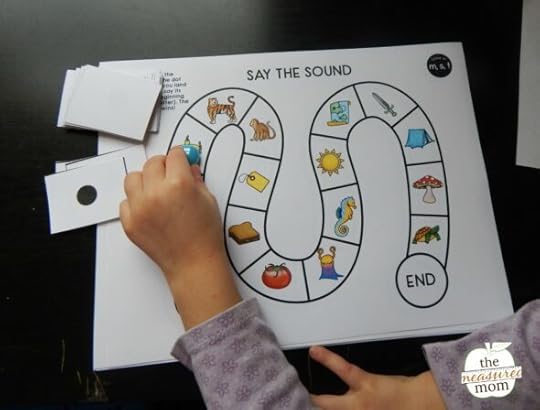
Play these phonemic awareness games to help your child isolate beginning sounds in words.
Print these cards , and have your child identify which picture starts with a different sound.
If your child is ready for something more advanced, use these elkonin boxes to help him/her separate sounds in words.
Reading
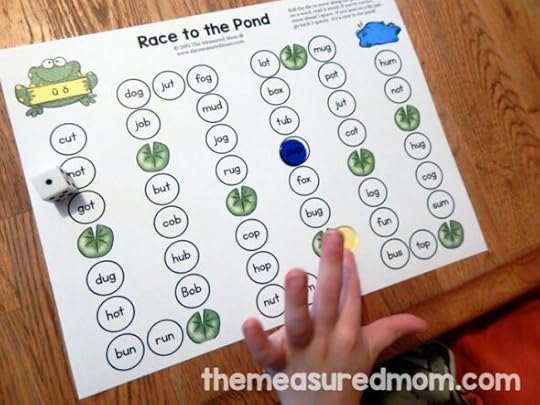
Practice reading CVC words.
CVC stands for consonant-vowel-consonant. These are the first words we teach kids to sound out (words like��cat and��bug), and I have loads of freebies on my site. Check them out below:
Try this word building mat with cards.
Print and use these CVC word board games.
Check out all my printables for short vowel words … including simple games and worksheets. Start here and scroll to see them all.
Move on to words with beginning digraphs and blends.
If your child is fluent with CVC words, it’s time to move on to the next step.
A digraph is two letters that make one sound (sh, ch, th, wh, kn, wr). A blend is two letters that appear together but make their own sounds (fl, st, etc.).
Here are some single player digraph games.
Here are some 2-player games for digraphs and blends .
More advanced learners can play my fast and fluent games for words with beginning blends.
If your child is ready, practice reading silent e words.
Many kindergartners will not be able to do this before first grade, but if your child’s reading ability is advancing quickly, move on to silent e words (cake, game, etc.)
Start with these games that help children hear long vowel sounds in words.
Here are some fold and read cards.��
Try a silent e four in a row game.
Find books your child can read on his/her own.
This may be difficult if your library is closed (as ours is). If it’s not, however, or you’re not opposed to spending some money, check out this post with a list of books for different levels.
Handwriting
This is something that can quickly fall apart without daily practice. It’s a good idea to have your child fill out a short handwriting page several times a week.
Free level 1 handwriting pages (super easy and more for preschool)
Free level 2 handwriting pages
Free level 3 handwriting pages
Free level 4 handwriting pages
Writing
Creative writing is important even for kindergarten! It just looks different. If you’re interested in learning more about this, get some paper, pencils, and markers – and follow the tips in my free blog series about teaching writing in preschool and kindergarten.��
Try incorporating some form of writing (as described in the above blog series) this into your day a couple of times a week – more if you and your child love it!
Math
Practice counting and number recognition.
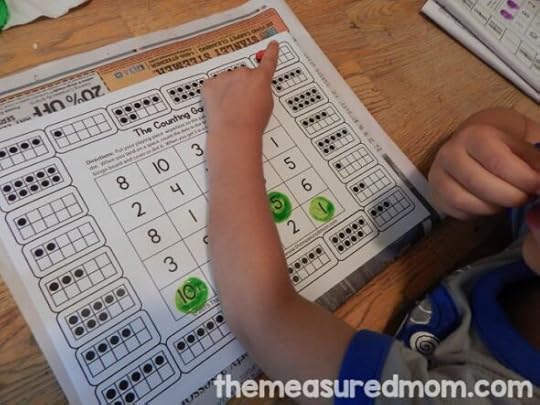
Try these one-player counting games , which come in a variety of levels of difficulty.
Try these hands-on number worksheets for practice with numbers 11-20 .
Play this fun teen number BINGO.
If your child is solid with the teen numbers, do a lot of work with numbers up to 100. I recommend doing activities with a 100 chart. Here’s a free 100 chart and ten ways to use it.
Do simple addition and subtraction.
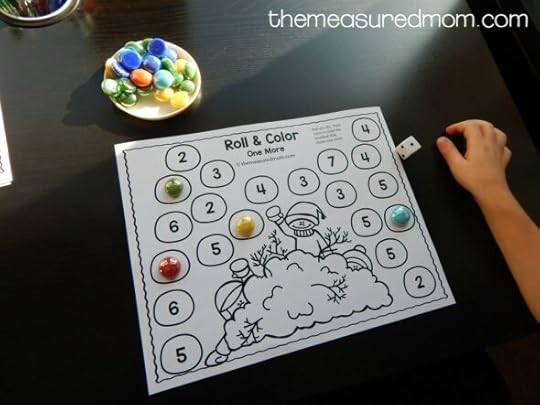
I know we’re moving into spring, but these winter roll and color games are fun.
Here are some other activities:
Make 10 addition games
Ladybug addition mat
Monster missing addends (these take some time to put together)
Subtraction Race board game using flash cards
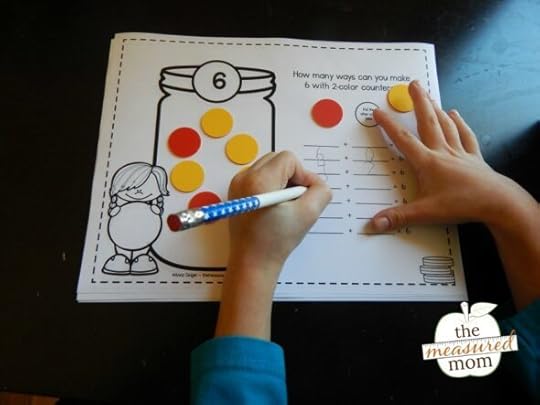
Practice writing addition number sentences with these printables:
Addition with 2 color counters (you don’t need 2-color counters; just use two types of manipulatives – they can be coins, caps, etc.).
Do this bugs in a jar addition game if you have some toy bugs at home.
Do simple addition and subtraction word problems with sums up to 10 (or subtracting from numbers up to 10).
You don’t need any printable for this. Simply make up some simple word problems using toys, silverware, etc. Have your child use physical objects to solve the problems if needed. I recommend including a few of these in your math practice each day (or simply fit them into your playtime naturally).
“If I have 5 forks and you give me 4 more, how many do I have now?”
“If you have 3 dimes and 3 quarters, how many total coins do you have?”
“If you have 10 crackers and you eat 3, how many are left?”
Practice identifying 3-D shapes …
Go on a hunt around your house. Can you find examples of the common 3-D shapes? (cylinder, cone, cube, triangular prism, rectangular prism, and sphere)
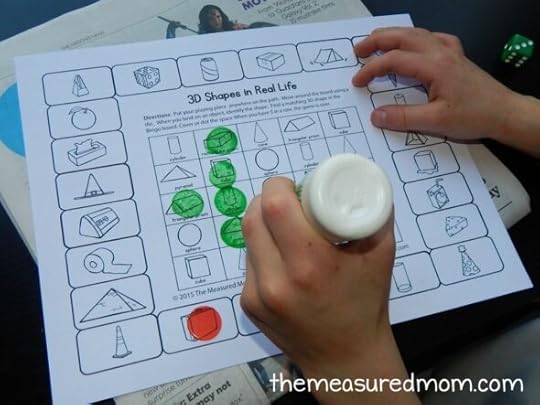
Try these simple one-player games.
Play these 2-player 3-D shape games.
Those are the academic skills I recommend working on, but you have a whole day ahead of you. What else should you do?
Read, read, read to your child. Do this as often as possible – for as long as both you and your child are enjoying it. Normally I’d tell you to choose to check out my book lists and head to your library. I realize that may not be an option now. Do the best with what you have.�� Be sure to talk about books as you read. Here are my tips for doing that.
Need books to read but you can’t get to the library?
Get a free one month trial of the app Skybrary (with LeVar Burton from Reading Rainbow) – we used this in the past and loved it.
Get a free one month trial of Epic! , a great digital library for ages 12 and under. We use it and love it.
Get moving. If possible, get outside.If you’re stuck indoors, here are some indoor gross motor activities.
Pull out things that will keep your child busy.��
Make homemade play dough , or buy it online.
Order kinetic sand . This stuff keeps my preschooler and kindergartner busy for 30 minutes at a time – or more! Plus, it’s easy to clean up.
Do simple art projects. Browse Pinterest and you’ll find some easy activities you can do at home. Here are a bunch of ideas from Happiness is Homemade . I also recommend creating small cards/crafts that you can mail to family and friends.
If you can, Facetime grandparents and other relatives.
Cook together. Here are a bunch of fun ideas.
Do simple science projects, like these.
Play with building toys – Duplos , Legos , Magna Tiles , etc.
Play board games. Games my kindergartner currently loves are UNO , Sequence for Kids , Mancala , Qwirkle, and Penny Drop .
Find some free drawing tutorials on YouTube. We absolutely love Art for Kids Hub and use it��all the time.�� Here’s a playlist of the easier drawing projects.
Give them screen time. Yes, I said it. I recommend planning this for specific times in the day – as late in the day as possible so you save it for when you really need it. Here’s a list of free education sites for kids.

I hope this helps as you plan for several weeks at home. Please feel free to reach out to me through my email: anna(at)themeasuredmom(dot)com.
My inbox is bursting these days, but I do my best to answer every message.
Hugs to you!
Anna
© 2020, Anna G. All rights reserved.
The post What to do with your kindergartner when school is cancelled appeared first on The Measured Mom.
March 16, 2020
What to do with your preschooler when school is cancelled
Are you trying to figure out what to do with your preschooler when you’re stuck at home due to school cancellations?
I’m here to help!
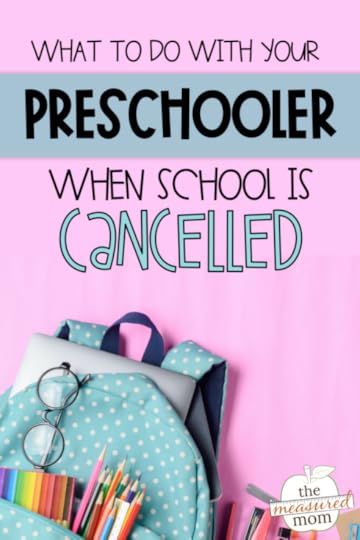
These are crazy, unprecedented times. The fear of COVID-19 has gripped the world. Travel is discouraged, school is cancelled, and many of us find ourselves home with our kids without anywhere to go.
As you figure out how to fill the days with your child who is home from PreK, I hope this post helps!
What to do with your PreK child
I recommend having a small portion every day when you do “school.” This does not need to be long, and you can break it into several sessions throughout the day. 30 minutes (total) really is enough. You might also want to do two 30-minute blocks, depending on your child’s attention span.
What you work on will depend on where your child is at developmentally.
Remember … 30-60 minutes a day is plenty! You can break it up into 2-3 sessions if needed.
*Only free resources are included in this post, but you are always welcome to check out my shop and online membership.
Pre-Reading
If your child is still learning letters …
Write capital and/or lowercase letters on a piece of paper, one at a time. Have your child name each letter as you write it. Keep track of the ones your child doesn’t know. (This may get tiring; break it up into more than one session as needed.)
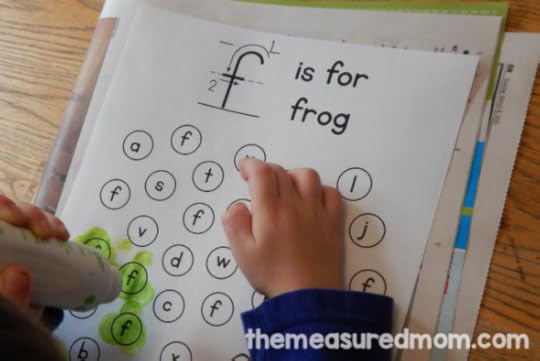
Play games to practice the unknown letters, but always include the letters your child knows as well. Just a few unknown�� letters at a time is a good idea.
Make a matching game out of slips of paper�� or index cards cut in half.
Write letters on post-it notes. Then write the same letters on post-it notes again. Put one set all around the living room. Have your child match the other set to the posted letters.
Print and sort letter cards. This blog series has printable letters at the end of every post.
Try my free letter find pages .
Play my free Alphabet Four-in-a-Row .
Join my email list to get my alphabet bingo cards for free.
If your child knows letters but doesn’t know his/her sounds yet …
Start by having your child listen to sounds at the beginning of words without matching those sounds to letters. These free clip cards will help.
Focus on one letter at a time using these free letter sound cover pages.��

Create a simple game with letters whose sounds your child needs to work on ( here’s a free resource ).�� ��Include just a few letters at a time, and start with the easier sounds: /b/, /d/, /f/, /j/, /k/, /m/, /n/, /p/, /s/, /t/, /v/, and /z/. Move on to harder sounds: /c/, /g/, /h/, /q/, /l/, /r/, /w/, /x/, and /y/. Conclude with the short vowel sounds.
As your child gets better at letter sounds, you might try these simple letter sound parking lots with toy cars (my now second grader��loved this as a preschooler).
Whether or not your child knows letters and sounds, practice RHYMING …
Rhyming is a super important skill, and I have loads of free resources to help you out. If your child doesn’t “get” rhyming yet, try this free game . It helped the concept click for my younger daughter.
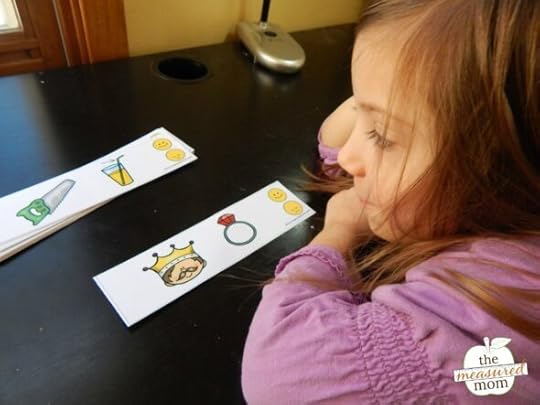
Here are other fun, low-prep rhyming printables on my site:
Rhyming matching game
Rhyming pinch cards
“I can rhyme” board game
Rhyming clip cards
Roll-a-Rhyme (this one is more advanced)
If your child knows the letters and their sounds …
Work on phonemic awareness, which is the ability to play with sounds in words. Start by watching this video to understand what phonemic awareness is.

Play these phonemic awareness games to help your child isolate beginning sounds in words.
Print these cards , and have your child identify which picture starts with a different sound.
If your child is ready for something more advanced, use these elkonin boxes to help him/her separate sounds in words.
If your child is ready to read …
You can start working at blending sounds together in short words. But please check out this post to make sure your child has the necessary pre-reading skills.
A fun way to start blending sounds into words is with successive blending. This post has a free video and printable to get you started.
Along with successive blending, you could try sounding out words using word families. Try this word building mat with cards.

It can take quite some time to be fluent with 3-letter short vowel words, but if your child is really rocking it, print and use these CVC word board games.
Fine Motor / Handwriting
When your child is in kindergarten, s/he will be expected to hold a pencil and write letters. It’s good to get a head start on this in PreK, but building fine motor skills should come before handwriting practice.
Help your child build hand strength by doing the following:
Squeezing play dough
Squeezing newspaper up into balls and throwing it into a basket
Use a squirt bottle to water plants.
Play with sponges in the bath tub.
Use a single-hole punch to cut holes in construction paper.

“Write” letters without using pencil and paper.
Write one letter at a time on a piece of paper. Show your child how to use your finger to “write” the letter in a tray of salt, flour, cornmeal, etc. Remember to use proper letter formation (starting at the top). Have your child “copy” the letter with a finger.
When your child is ready for simple handwriting practice with pencil and paper, you can start with my letters of all sizes handwriting pages . I recommend starting with uppercase letters first.
Have your child write his/her name every day. This may begin with you writing it with dotted letters and having your child trace it. Here’s a post with .
Math
Practice counting.
If your child struggles with counting small groups of objects, this post has ideas that will help.
If your child is ready for counting larger groups, try these gumball counting mats , which go up to 20. Use pennies if you don’t have small counters.

More advanced learners can try these one-player counting games , which come in a variety of levels of difficulty.
Work at number recognition.
If your child doesn’t know any numbers yet, this free number tracing book is a good place to start. Just print the numbers 1-10.
Join my email list to get these free number find worksheets.
Try these hands-on number worksheets , one of the most popular resources on my site.
If your child is ready, do simple addition.
No flash cards, please! Try these games to introduce the concept.
Grab two dice and play this ladybug roll and cover game.

I know we’re moving into spring, but these winter roll and color games are fun.
Here are activities for more advanced learners:
Make 10 addition games
Ladybug addition mat
Monster missing addends (these take some time to put together)
If you want to do more math activities, here are some to try …
Sort coins.
Do other simple sorting activities .
Use these shape clip cards.
Work at patterns with this truck patterns pack .
Those are the academic skills I recommend working on, but you have a whole day ahead of you. What else should you do?
Read, read, read. Do this as often as possible – for as long as both you and your child are enjoying it. Normally I’d tell you to choose to check out my book lists and head to your library. I realize that may not be an option now. Do the best with what you have.�� Be sure to talk about books as you read. Here are my tips for doing that.
Get moving. If possible, get outside. Here’s a fun game that you can play in your backyard – it even incorporates math skills! If you’re stuck indoors, here are some indoor gross motor activities.
Pull out things that will keep your child busy.��
Make homemade play dough , or buy it online.
Order kinetic sand . This stuff keeps my preschooler busy for 30 minutes at a time – or more! Plus, it’s easy to clean up.
If you are up for it, provide simple sensory play. This can be a pain to clean up, but kids love it (and it’s good for them). Here are some ideas from Teaching Mama.
Do simple art projects. Browse Pinterest and you’ll find some easy activities you can do at home. Here are a bunch of ideas from Happiness is Homemade . I also recommend creating small cards/crafts that you can mail to family and friends.
If you can, Facetime grandparents and other relatives.
Cook together. Here are a bunch of fun ideas.
Do simple science projects, like these.
Play with building toys – Duplos , Legos , Magna Tiles , etc.
Play board games. Candyland may not be your favorite, but my own preschooler wants to play this multiple times in a row. (Every.single.day.) Other games my preschooler currently loves are UNO , Pengaloo , Sequence for Kids , and Penny Drop .
Give them screen time. Yes, I said it. I recommend planning this for specific times in the day – as late in the day as possible so you save it for when you really need it.

I hope this helps as you plan for several weeks at home. Please feel free to reach out to me through my email: anna(at)themeasuredmom(dot)com.
My inbox is bursting these days, but I do my best to answer every message.
Hugs to you!
Anna
© 2020, Anna G. All rights reserved.
The post What to do with your preschooler when school is cancelled appeared first on The Measured Mom.
March 15, 2020
5 Secrets to giving strong writing conferences

TRT Podcast#7: 5 Secrets to Giving Strong Writing Conferences
A writing conference is a conversation with a learner about his or her writing work. Nothing will help you get to know your students better as writers and as people!
But how do you know what to say and do during a writing conference?
These five secrets will give your conferences a powerful boost!
Listen to the full episode
Full episode transcript
Hello, Anna here, and I'm so excited to welcome you to episode seven: Five secrets to giving strong writing conferences.
This episode is brought to you by my Writing Workshop Guide. Whether you're new to writing workshop or an experienced workshop teacher, you will love this giant printable handbook with mini-lesson ideas, lists of mentor texts, and countless resources for improving your writing workshop curriculum, including over 150 printable charts and resources.
Before we dive into those five secrets to giving strong writing conferences, let's talk about what a writing conference is. It's a conversation with a learner about his or her writing work, and I have got to tell you that in my years of teaching, nothing helped me get to know my students better as writers and as people than those one-on-one writing conferences. Both my students and I loved them.
Here's a quote from Shubitz and Dorfman in their book, Welcome to Writing Workshop. "Writing is hard work, and some students will need a conference to cheer them on to do the necessary work to grow as a writer." That's a great quote, but those authors would also tell you that everyone will benefit from writing conferences because they're more than a chance to encourage your students.
Writing conferences are unique because your learner has your undivided attention focused solely on them. It's your opportunity to individualize your instruction and give this particular learner exactly what he or she needs.
There are so many things you can do in a writing conference. You can help a learner get started. You can provide individual modeling for a particular child. You can give immediate feedback. You can identify a problem that you're going to work on together. You could teach informally, and we'll get into that later on. You can help them set goals for future writing work.
Writing is deep, personal, hard work, and students need that support from you. These conferences will build a stronger relationship between your students, while boosting their writing ability exponentially. So if that sounds good to you, let's go ahead and dive into those five secrets to giving strong writing conferences.
Number one, listen first. THEN decide and teach. Something we need to remember is that a conference is a conversation, not a mini-lecture. So unlike mini-lessons , where we're prepared in advance and we go into the lesson knowing exactly what we're going to teach and we have all our supplies ready to go, most one-on-one writing conferences are somewhat unplanned.
If you're a planner as I am (and most teachers are!), that might make you feel a little uncomfortable. It does take some getting used to, but we have to let go of our need to plan everything in advance and just be a listener.
Here's a great quote from Carl Anderson. He titles his classic book about writing conferences, "How's it going?" because that's what he says when he pulls up a chair next to a student writer. Here's a quote. "By truly listening to them as we confer, we let them know that the work they're doing as writers matters. It's the way we listen more than anything else that will nudge our students to talk about what they're trying to do, to use the words they haven't used before, and to look at us with a smile instead of a frown when we kneel down next to them and ask, "How's it going?"
When you first pull up a chair and sit down next to a student writer during that independent writing portion of the workshop and you say, "How's it going?" you'll probably be disappointed by the answer. Most likely you will hear something like, "Good" or they won't say anything at all.
That is completely normal and to be expected. But with time and practice, you'll teach them that you're looking for specific information. You want to know what they're doing as a writer.
So maybe a kindergartener will tell me, "I'm drawing a picture of a dinosaur, " or maybe a second grader will tell me, "I'm adding a simile to my poem. " Or a third grader will tell me, "I'm using the editor's checklist to edit my report." You get the idea.
We call this phase of the conference the research phase. You're listening and finding out where they're at so you can make a decision as to what direction to take the conference.
If you're sitting down next to somebody and they're just sitting there completely lost, they're daydreaming, and there's nothing on their paper, this conference may be about how to find your own writing topic. It won't be you giving a writing topic, but it will be you equipping them to find their own topic today, supporting them as they do that, and then making sure they can do that on their own the following day.
Be sure that you say something positive about the student writing before you move into the teaching point. That's really important because remember, writing is so personal. If I did a multiplication problem on a piece of paper and I did something wrong, and got it wrong, and someone said, "Oh, you made a mistake here," it probably wouldn't hurt my feelings.
But if I wrote something from my heart and someone said, "That's boring, or that's dumb, or what were you thinking?" that would hurt my feelings. Our students are the same way. They are sensitive about their writing. Everybody is. So be sure to say something positive before you get into things that they can do to fix their writing or to make improvements.
Now let's move on to secret number two. Teach the writer, not the writing. If you've ever done any research or professional study about the writing workshop, I'm sure you've heard this because it's repeated over and over. It's from Lucy Calkins in her groundbreaking book, The Art of Teaching Writing, that was published over 25 years ago.
But this advice is still very good. Here's what she said. "Our decisions must be guided by what might help this writer rather than what might help this writing."
So what does that mean? It means that when you're looking at a child's writing and you see all the messiness and all the mistakes, you take a deep breath and you remember your job is not to make this piece of writing perfect. It's not because that's not going to serve them. Your job is to teach the writer one thing he or she can use to improve this writing and the writing they do in the future.
Make sure that what you are teaching is transferable. As you do this teaching in your one-on-one conferences, you can approach it in a variety of ways. You can just say it. For example, "When writers write, they leave spaces between words. Let me show you how to do that. Let's practice doing that for your next sentence." Or ... "One thing you can do when you want to add something to your writing is use this little mark right here. It's called a caret. Let me show you how to add words to your writing."
You can use a mentor text. So You could say, "Let's work on crafting a strong beginning for your writing. I have a couple of books here. Listen to how these authors started their books and think about if you could start your story in one of these ways."
As you're deciding what to teach, here are some questions to ask yourself. What would help this writer the most, right now? Or this student is struggling, so what easy thing can I teach that will give them a quick success and a boost in confidence?
Sometimes you have a writer who is so strong, you're not sure what to say. So try to think about the next step for this writer. What's something else they can try that will make them even better at what they do?
After you've taught that skill or strategy, it's important then that your student knows that you expect him to do the work you taught right away. So what you could say is, "Tell me back what I just told you or what are you going to do next? Tell me about your next plans for your writing."
You might want to write it on a sticky note and put it right there in their writer's notebook to remind them and make sure you take notes for yourself so that the next conference you have, you can follow up to make sure they did what was expected of them.
Secret number three to strong writing conferences is to be prepared. A really good idea is to have maybe a tote bag that you call your conference bag, and inside of it you include all the things you might need for a writing conference.
Writing conferences have to be short so that you can meet with as many students as possible; you don't want to be running back to your desk to grab something. Here are the types of things you might put in your conference bag. Paper and pencil to demonstrate writing for your student or to model it. Scissors and tape to show them how to cut and paste while revising. Sticky notes. A record keeping system in a binder or a notebook so you can keep track of what's been discussed at the conference. You might have a personal writer's notebook that you like to share, maybe one from a previous year that you could put in your bag. Your favorite mentor texts, that's a really good idea. There are a lot of mentor texts that can be used to teach many skills. So having some of those in your bag is a good idea. An editor's checklist for students who are ready for that. Mini anchor charts, a portable word wall, highlighters.
As time goes on, you will see what things you need to keep in your bag, but those are just some ideas to get you started.
It's also helpful ,whether you're new to conferences or even experienced at them, that you have something of a cheat sheet, because very often you can be tongue tied in your conferences. You might be sitting there and you've listened to them tell you about what they're doing ,and you have no idea what to teach next. Don't feel bad about that. That is completely normal and to be expected and the more you teach writing workshop, the more you do these conferences, the better you will get at thinking of things on the fly.
But it's really helpful to have a cheat sheet ready for you. So I have a special gift for you, the listeners of this podcast. Head to the show notes, the measuredmom.com/episode7 and you will be able to download a guide that gives ideas for what to teach, and when, to K to 3 writers during writing conferences.
This comes directly from my ebook that I mentioned at the beginning of this episode, my Writing Workshop Guide for K to eight. In that book I put everything I know about teaching kids to write well, and it's wildly practical for K to eight.
Just the other day a buyer of the guide shared this review: "So helpful. Another teacher at my campus actually told me about your website. Her students are great writers and I was curious how that happened. She said you need to look up the Measured Mom, and well, the rest is history. "
That made me really happy to receive because it shows that the writing workshop works; this guide will really help you get started.
Just a side note. If you are a member of my course, Teaching Every Writer for K to 2, you do not need that ebook because the course Teaching Every Writer is jam packed with everything you need to teach writing in K to 2. And if you'd like to learn more about that, go ahead and visit teachingeverywriter.com.
Let's move on to secret number four. Set up a system that you can manage. You need to decide what your goal is for the number of conferences that you hold each day.
Now it's possible that you're also doing small group conferences. I didn't talk about those in this episode because that's a whole other topic. You could certainly learn about that in Teaching Every Writer, or to a small extent in the ebook. But let's imagine that you're mainly focusing on one-to-one conferences and I'll be honest, that's what I did as a classroom teacher. I did not do small group conferences, although they're certainly a good way to go. If you're doing just one-on-one, which you should certainly include, even if you're doing small group conferences, take a look at how long your independent writing period is and decide how many conferences you could probably fit in every day.
So let's say your independent writing time is 30 minutes. If each of your conferences is about seven minutes long, you could do four conferences per day. The goal is probably to make them a little bit shorter than seven minutes. The fact is some will be really quick and some will probably be longer than seven minutes. It does take a lot of practice to keep them manageable. As you're thinking about how many you might fit in per day, have a timer next to you and set it to help you keep your conferences on track. So if your goal is to have six-minute conferences, maybe it can be at five minutes to remind you it's time to wrap things up. And don't be too hard on yourself, because at the beginning your conferences will be much too long. Something you can do is squeeze them in other times of the day, like if someone comes in early or maybe it's math time and a couple of kids have finished their math work and you might want to pull them up and have them do a writing conference. Those are things you can do. It doesn't just have to be during independent writing time, so get a little creative because your goal is to meet with everybody, every one to one and a half weeks if you can.
You're going to have to decide who will initiate the conferences. As a teacher, I sometimes had students sign up for conferences. The challenge for that was that a lot of times they didn't think there was anything they could do until they had met with me. So they would just be sitting there saying, well, I'm waiting for a conference. Well, that could take until the next day or two days later.
So make sure that they understand what they're supposed to do while they're waiting for you. They can't just sit there. Some teachers like to have a visual in the front of the room. Maybe a foam board and on the left side it says waiting for a conference and on the right side it says had a conference and then you have names on clothes pins and you transfer those. Maybe you could move all the clothes pins back to the left at the beginning of each week. That's a quick reference for you. So if you're not sure who to meet with, you can quickly see who you've not yet met with that week.
You'll also want to make sure that you have a strong management plan so your students do not interrupt you during conferences. That goes back to the mini-lessons we talked about in the last episode, in episode six. So you'll have those procedural mini-lessons to teach your students exactly what to do when they need help; it has to be a very strict enforced rule that students do not interrupt writing conferences.
My final secret for giving strong writing conferences is just to get started ,because you won't get good at something until you start doing it. And I want to tell you that once you give it some time and start getting into these and make these a regular part of your routine, they may become one of your favorite parts of the school day - and your students' as well!
Sometimes you will draw a blank during writing conferences ,and other times you'll know exactly what to say. Sometimes conferring may feel like a burden, and other times it gives you a tremendous boost. Try to remind yourself that everyone has good and bad conferring days. It's a joy and a privilege to enter your students' lives through their writing.
Remember that in the show notes,I have a cheat sheet for you to help you know what to say during writing conferences in K to three, and I also share links to writing conferences on YouTube so you can see exactly how writing conferences look. I know that seeing and hearing them can be extremely helpful as you're trying to figure out how to implement these in your classroom, so head to the measuredmom.com/episode7 to get all those resources.
Thanks so much for listening ,and I look forward to talking to you again soon!
+ Click to view entire transcript
- Click to collapse
Episode freebie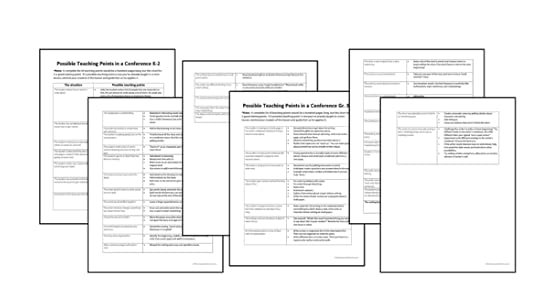

Related resources
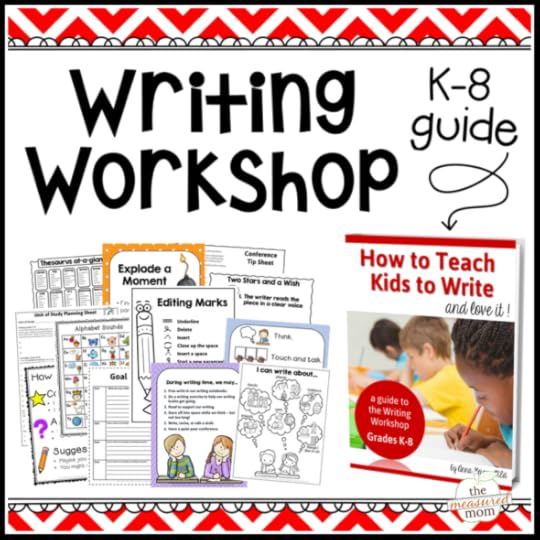
This ebook is a practical resource for both teachers and homeschoolers!
Whether you���re new to the��Writing Workshop��or an��experienced workshop teacher, you���ll love this giant handbook for teaching writing in grades K-8. In addition to this helpful guide, you���ll also receive over 150 pages of printable resources!
Click here to learn more about my Writing Workshop Guide.
Teaching Every Writer, my online course for teaching writing in K-2. Learn more here.
Blog posts
How to help learners find their own writing ideas
The best mentor texts for teaching narrative writing in K-2
Quoted resources
How’s It Going? by Carl Anderson
The Art of Teaching Writing , by Lucy Calkins
Videos of writing conferences
Conferring with a variety of students in kindergarten
Revising conference (1st grade)
Conference with a second grader
Teaching a student to write for an audience (3rd grade)
Resources for members of The Measured Mom Plus
Quick video training: How to get started with writing workshop in K-2
Quick video training: How to get started with writing workshop in 3rd grade
Printables for teaching writing
Subscribe & review in iTunes
Are you subscribed to my podcast? If you���re not, I want to encourage you to do that today. I don���t want you to miss an episode!�� Click here to subscribe in iTunes!
Now if you have an extra minute, I would be really grateful if you left me a review over on iTunes , too. Those reviews help other people find my podcast, and they���re also fun for me to go in and read. Just click here to review. You’ll need to click to “Listen on Apple Podcasts” and “write a review.”�� Let me know what you appreciate about the podcast. Thank you!
There are many ways to listen …
Subscribe in iTunes
Subscribe in Spotify��
Subscribe in Stitcher
Looking for the entire podcast library?
Click here to see all episodes.
© 2020, Anna G. All rights reserved.
The post 5 Secrets to giving strong writing conferences appeared first on The Measured Mom.
March 7, 2020
How to give short, powerful writing lessons
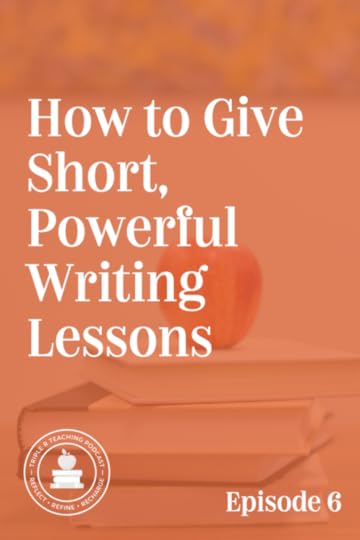
TRT Podcast#6: How to Give Short, Powerful Writing Lessons
Our students need time to write … but they need instruction first. How can you give short, powerful lessons that will teach your students what they need to know and still give them time to practice their writing?
This episode will answer the following questions:
What are writing mini-lessons?
Why should we give them?
What types of mini-lessons should we give?
What’s the ideal structure of a mini-lesson?
How do we know what to teach?
Click the play button to listen
Remember that you can hover over the player to speed up or slow down the audio.
Hello, Anna here, and I want to thank you for tuning in to episode six: How to give short, powerful writing lessons. This episode is brought to you by Teaching Every Writer, my online course for teaching writing in K-2. To learn more, please visit teachingeverywriter.com.
Let's start today with a little bit of reflection. How are you teaching writing in your classroom or homeschool? Here are the scenarios that I see most often. I see writing taught within the context of English class. So the teacher switches between grammar units and writing units, and there may be several weeks of a unit on verbs, and then they'll switch to a unit on writing personal narratives. And then they'll go back to a grammar unit. Each of those writing units is rather short and does not allow students to create a lot of writing pieces. It's often based on having them create just one strong piece. The teacher has a lot of rules that have to be followed, and the students complete the piece all at the same time. So everybody pre-writes, everybody drafts and so on, and there's a due date for that piece of writing.
And then I also see students writing every week or possibly even every day, but just for a short period of time and without a lot of instruction. So there's a prompt on the board, or there's a journal and students are told to write about what they did over the weekend, but there isn't a lot of teaching writing skills. It's just giving students practice. If one of these scenarios sounds familiar to you, I would encourage you to think differently about how you approach teaching writing. Every day or at a minimum, three days a week, I recommend giving a short writing lesson and then following that up with a longer period of independent writing that's at least 20 minutes, preferably 30 to 40 minutes for sure in first grade and up. And then during that writing period, the students will hopefully apply what you taught them in the mini-lesson. Then you'll conclude your writing time with a short share time. If this sounds like what you're already doing, you likely call it Writing Workshop, and the tips I share today will help you make those writing lessons even more effective.
In today's episode, we're going to answer five questions about these short, powerful writing lessons, which we like to call mini-lessons. So here are those questions. What is a writing mini-lesson? Why give them? What types of mini-lessons should we give? What's the ideal structure of a mini-lesson? And how do you know what to teach in your writing mini-lessons?
Let's go with that first question. What is a mini-lesson? A writing workshop mini-lesson is a short lesson with a narrow focus, and we give this lesson at the beginning of writing time to help our students learn essential elements of writing. Often we're teaching a skill or a concept that's part of a larger unit of study. So for example, if we're doing a poetry unit, a lesson that fits really well is using figurative language. Or if we're doing a unit about personal narratives, we might have a lesson about zeroing in and focusing on one small moment. Two key things you need to remember about mini-lessons is they are mini, and they focus on just one skill or strategy.
Question number two, why? Why give mini lessons? Why can't we just let our students write, because that's what they need to do to become better writers? Well, it's absolutely true they need to write to become better writers, but practice itself isn't enough to develop strong writers. Think about our students when we're teaching them reading. We wouldn't just give them books and say, "Okay, now it's time to read," without giving them any instruction beforehand. They need to learn about phonics and comprehension and fluency. There are so many things we need to teach them before we have them practice those skills, and writing is no different.
Our learners absolutely need that long period of writing time, but they need the instruction first. A caveat though ... yhey are called mini for a reason. It is very easy to turn a mini-lesson into a maxi-lesson because we're teachers for a reason, right? We like to talk. But we never want our mini-lessons to encroach on student writing time. We don't want to spend most of our workshop teaching our students about writing instead of giving them time to write. They need more than 10 minutes to write (really, they need more than 15 minutes). Think about the last time you sat down to write something. Did everything just flow automatically and you just kept going and going, or did you have some stops and starts?
Sometimes it can take a long time to get that writing train moving, whether we're first graders or teachers or professional writers. So we have to build in that time. Writing is very different than picking up a book and reading or doing a math worksheet or something else that we often do during the school day. It requires a lot of deep thought just to get going and to keep going, so we need to build in that long period for our students to write.
Let's move on to number three. What types of mini-lessons should you give? There are three types. One of them is procedure and organization, where you teach things that will help your writing workshop run smoothly. These will vary depending on your students and your grade level, but typically you will do a lot of this type of mini-lesson whenever you initiate the workshop, whether that's September, January, or another month of the year. You will teach things like where to get supplies, how to cross out instead of erase, maybe how to skip lines to save room for revision. Or if you're teaching kindergarten, "Here's how to use a stapler to add more pages to your writing." Think of these as mini-lessons that will help your workshop run smoothly and help decrease interruptions, because you're teaching your students how to work independently.
Writers' craft mini lessons help students improve the quality of their writing by showing them how texts are written. So you might talk about things like how to choose a topic, how to write for an audience, how to write a strong beginning, or how to use strong verbs or adjectives.
And finally we have convention mini lessons, which if I'm being honest, are what we mostly tend to give because they're what we know best. These are lessons about spelling, punctuation, grammar, and things like that.
So when you think about the big picture of all the types of mini-lessons, which would you say would be the one that we should give the most of? I'm not sure there's an actual answer for that, but I think we need to be careful not to be too heavy on one of them. We'll do a lot of those procedural mini-lessons at the beginning of the year with the beginning of writing workshop, but we don't want to go too heavy on conventions the rest of the year. We want to balance that with writers; craft. After all, a piece of writing can have really great spelling and perfect punctuation and sentence structure, but be really bad. That's why we have to spend a lot of time teaching our students how to improve the quality of their writing.
Let's move on to the next question. What is the ideal structure of a mini lesson? Well, when you're planning your mini-lessons, the first thing you want to do is determine your goal. Remember that we don't teach mini lessons to cross something off our to-do list or to cover a skill. We want our students to transfer this knowledge to their own writing. So when you're planning your lessons, ask yourself: what is the point of this lesson and how can my students use this understanding to make their writing better? Once you know your goal, you'll be able to introduce it to your students and link it to their current work. So you might say something like this, "Boys and girls, I've noticed that a lot of you are writing longer stories about things that you do at home, which is wonderful. Some of the stories I've seen are what I like to call bed-to-bed stories. You write about when you get up and you write about everything you did until you went to bed. Today I want to show you how to focus on just one part of your story." So you see how I talked about what I've seen them doing and I linked it to what we're going to talk about today.
And then you're going to teach your lesson. And it is hard, I know. It is hard to keep it short. You may have to teach a concept over two days, but what you don't want to do is have a whole lesson take up most of the writing time.
When you're teaching the lesson or the skill you want to think about varying the way that you present it. So here are some things you can do. One thing I definitely recommend doing a lot of is writing in front of your students. That means letting them see you go through the whole messy process of writing, coming up with a topic, writing a beginning, and deciding what sentence comes next. That would be modeling. You can also do shared writing, which is where you write something together. You're taking a lot of their input as you decide what to write next.
If you're teaching a procedural mini-lesson, you probably can just say what you want them to know. So for example, "Boys and girls, today I want to show you what we do in writing workshop to keep ourselves moving. We use these pencils without erasers, and when we write something we don't like, we draw a single line through it so we can see what we wrote before and we write on top of it or next to it, the new thing we want to say." Then you would just demonstrate.
Many of these mini-lessons can be very simple, but they could also get more complex. If you're teaching something more complex, when it comes to writers' craft, a great thing to do is to use a mentor text. That's when you take a published piece of writing, and you read a part of it, not the whole thing. But you read a part of it and then you show students how they can try that in their own writing. Maybe it's a book that uses sound words, or a book that uses some type of figurative language, or even a certain type of punctuation like an ellipsis. Don't assume, though, that you can only use published mentor texts, because often students learn just as well or even better from student writing samples because that's something that's more within their reach and something they can aspire to. So consider sharing student writing with their permission, saving samples from previous years, or looking online because there are a lot of student writing samples. They're often called exemplars, and you can print them and put them on a screen and show your students.
Another thing you could do in a writing mini-lesson is to make an anchor chart. So maybe your lesson is all about how to find topics for writing ,and you get a big piece of chart paper and together you write down all the strategies that the children are using as they try to come up with ideas for writing. In that case, your students help you determine the content of your mini-lesson, because it depends on the things that they share with you and each other.
Sometimes a writing mini-lesson will continue with guided practice, and you have to be real careful with this. We're not talking about out worksheets (you might not use any printable at all). What it may be is just students doing something orally. So if your mini-lesson is about teaching students how to find a writing topic about a time they felt a particular emotion, you might say, "Now we're going to take one minute to think about something that made you really happy and then I want you to turn and talk to a partner about how you could use that for writing idea." So you can see how that's you helping them practice the skill without actually doing writing at all, and it doesn't have to take very long.
You could also do shared writing for your guided practice. So let's say that your mini lesson was all about writing the list of things you might write about for a non-fiction piece before you begin, a kind of brainstorming. And so then you might work together and say, "Okay, let's imagine we were going to write a piece about sharks. Who could help me think of some types of things we might include in our writing?" And so together you would make that list. And you would be giving them a chance to practice the skill with you.
After you do that guided practice, you're going to conclude by linking to their future work. You can think of this as a bridge. So what I like to say is "today and every day."
"So today and every day when you write a non-fiction piece about an animal or a person or a place, think about writing a list of things you might include in your writing before you start. That will get your brain going and help you think about all the possibilities for your writing."
Now we're on question number five. How do I know what to teach within my writing lessons? And this is the big question. How do you decide what to teach? Ask yourself what's developmentally appropriate for your learners, and also ask yourself what your students need to learn. You can find this out by looking at your standards or just observing. Do you have a student struggling to use a thesaurus in third grade? Model. Give a lesson about using a thesaurus well. Are your kindergarteners melting down and quitting when they don't know how to spell a word? Give a mini-lesson. Are your second graders writing bed-to-bed stories like I talked about a minute ago? Give a mini-lesson about focusing in on one event. Here are just a few examples of mini-lesson topics. You could have your students practice writing tricky letters in the air, that would be a kindergarten mini-lesson. For first and second grade, making a quick list before they write. For all children, finding topics in everyday life or what to do when they can't think of what to write about. Maybe first or second grade, using transition words in their writing. Maybe in second or third grade, skipping lines to leave room for revision or spider legs. That's when you write something on a piece of paper and tape it into your writing as a way to add more when you don't have space in the writing that you did originally. Teach your students to re-read their writing when they start the new day so they remember what they wrote the day before.
Inside our online course, Teaching Every Writer, we have the ultimate list of mini-lessons for K-2. Becky has put together a ton of mini-lesson ideas there for all areas. As a listener of this podcast, I have a special gift for you. Head to the show notes for this episode, themeasuredmom.com/episode6, and you will be able to download a mini version of that ultimate list of mini-lessons to get you started. And I will include ideas for kindergarten first, second and third grade because I know many of my listeners also teach third grade.
Now you might be thinking, "That's great. I'm glad to have a list of mini lessons, it's super useful, but what if I don't know what to teach within those lessons? So the lesson idea is teaching students to focus in their writing, but I'm not sure how to teach that."
Well, there are different things you can do. You can certainly purchase a done-for-you writing curriculum. I know that Lucy Calkins has quite a few writing units for all grades; people have different feelings on those. I have a lot of confidence in her pedagogy. However, I know that her units can be very wordy and hard to follow. And I'm not sure, but I've heard that some of the things she does feel a little scripted. I would definitely caution you to stay away from anything that's scripted or at least make it your own. So whether you buy Lucy Calkins' Units of Study, or if you purchase a unit on Teachers Pay Teachers, please use the unit with caution and flexibility. Remember that you are the ultimate authority in your classroom, and if a unit tells you what to do next and you think that's way too hard for most of your students, or that's way too easy, adjust and change.
There are some really good professional books out there with ready-for-you lessons, and I will link to many of those in the show notes that will help you get started. I'd also like to let you in on a little secret. In Teaching Every Writer, we have the best of both worlds. Not only does the course show you how to teach writing in K-2, from how to teach conventions, how to teach all the elements of writer's craft, how to give conferences, to the structure of mini lessons, but it also includes over 200 ready-to-use printable mini-lessons for K-2. The benefit of that is that you've got these simple easy to follow lessons that are just a single page each; they're also flexible. So you can pick and choose and use them whenever it makes sense for you. We don't have a specific recommended order. We have them there as a menu for you so you can choose what works best for your students. Please be flexible, whether you're using our resources or something else that you purchase. You want to be able to skip around or add to lessons that you purchase.
In today's episode we talked about what writing mini-lessons are, why you should give them, what types of mini-lessons you can give, the ideal structure of a mini lesson and how to know what to teach. As a reminder, I am sharing a list of mini-lesson topics in the show notes for this episode, and I'm also going to give you several of the writing mini lessons from Teaching Every Writer, so you can get a taste of the 200 writing lessons that are included in that course. So go ahead and go to the show notes, themeasuredmom.com/episode6 to get all your freebies. Thanks so much for listening, and I'll talk to you again soon.
+ Click to view entire transcript
- Click to collapse
Episode freebie
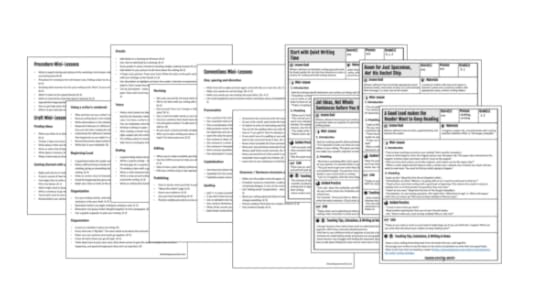

Related resources
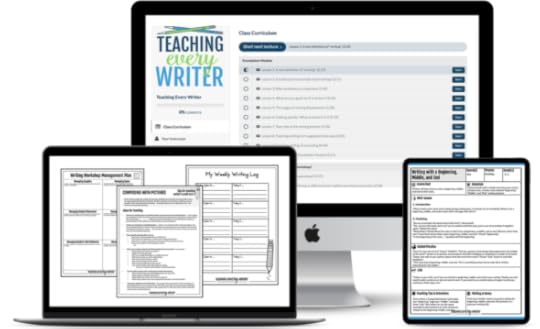
Teaching Every Writer, my online course for teaching writing in K-2. Learn more here.
Blog posts
What to teach writers in K-2
How to help students move from drawing to writing
How to teach young writers to spell on their own
Mentor texts for teaching writing in K-2
How to teach revising and editing in K-2
Excellent sources of mini-lessons for K-2
No More “I’m Done!” by Jennifer Jacobson
Into Writing: The Primary Teacher’s Guide to Writing Workshop , by Megan Sloane
Marvelous Mini-Lessons for Teaching Writing in K-3 , by Lori Jamison Rog
Resources for members of The Measured Mom Plus
Quick video training: How to get started with writing workshop in K-2
Printables for teaching writing
Subscribe & review in iTunes
Are you subscribed to my podcast? If you���re not, I want to encourage you to do that today. I don���t want you to miss an episode!�� Click here to subscribe in iTunes!
Now if you have an extra minute, I would be really grateful if you left me a review over on iTunes , too. Those reviews help other people find my podcast, and they���re also fun for me to go in and read. Just click here to review. You’ll need to click to “Listen on Apple Podcasts” and “write a review.”�� Let me know what you appreciate about the podcast. Thank you!
There are many ways to listen …
Subscribe in iTunes
Subscribe in Spotify��
Subscribe in Stitcher
Looking for the entire podcast library?
Click here to see all episodes.
© 2020, Anna G. All rights reserved.
The post How to give short, powerful writing lessons appeared first on The Measured Mom.
March 1, 2020
What does the writing process look like in K-2?
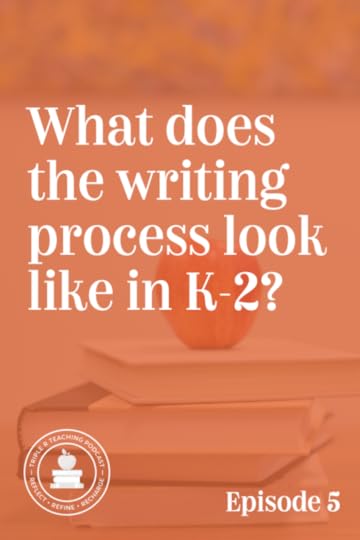
TRT Podcast#5: What does the writing process look like in K-2?
You know the stages of the writing process: prewriting, drafting, revising, editing, and publishing. But what exactly do they look like in K-2? This episode will give you strategies for helping your youngest learners become thoughtful writers.
Listen to the full episode
Full episode transcript
Hello, Anna here! Welcome to episode five: What does the writing process look like in K to 2? This episode is sponsored by Teaching Every Writer, my online course for teaching writing in K to 2. To learn more, please visit teachingeverywriter.com. This is the third in a series of Triple R Teaching episodes about teaching writing.
Two weeks ago, I shared 10 tips for teaching writing in kindergarten. Last week, I shared five things that will supercharge your writing instruction, and today we're going to look closely at the writing process in kindergarten, first and second grade. We all know the stages of the writing process. Your elementary teacher probably had a cute poster on the wall telling the difference between pre-writing, drafting, revising, editing and publishing. We know those stages ,and we may believe that we're teaching our students to use the writing process, but are we?
Too often we're providing writing prompts for journals or cute writing assignments to post in the hallway. We're rushing our students to complete those journal prompts because our 10 minutes are almost up or we want them to finish those writing projects that we can put them in the hallway before the weekend. Our students have gotten a little writing practice, but they haven't learned much about the writing process. Don't get me wrong, I love those writing displays in the hall as much as the next person and there are definitely times for those fun writing projects, but I encourage you to let go of this idea that every hallway display needs to feature the exact same writing topic. Don't let those be all or even the bulk of the writing that you do with your learners. Students need time to experiment with different topics and writing projects and make their own decisions about which pieces to bring to completion for publication.
So what do I mean by all of that? In this podcast, we're going to take a walk through each stage of the writing process and talk about how it looks in K to 2. Last week, I talked about having a period every day that your students write. I stated that I believe writing workshop is the best structure for teaching writing in all grade levels. It starts with that mini-lesson, continues with that long period of independent writing and concludes with sharing time. And the writing process is what's going to be happening in that middle chunk when students are doing their independent writing work.
Let's start with pre-writing. Pre-writing in the primary grades is very quick. In fact, I've said before, if you blink, you might miss it. In fact, pre-writing and drafting are almost indistinguishable, so don't worry too much about that. In the primary grades, often, especially in kindergarten, pre-writing takes the form of oral rehearsal. So it's students talking about the writing. In fact, in the book No More "I'm Done!": Fostering Independent Writing in the Primary Grades, by Jennifer Jacobson, she talks about a kindergarten teacher named Kelsey Frost who created three stations in her kindergarten classroom. One was where students would go to talk about their writing to talk through what they were going to write about. Another was where they drew their ideas and another table was where they actually did writing with letters and words.
At first, she was afraid that her students wouldn't move through the stations. They'd just want to sit there and talk or they wouldn't want to write, but to her surprise, the stations worked really well. To be clear, she didn't require her students to go through them in order. Some students would go directly to writing. But can you see how setting something up like that can help your students understand that writing is a process? Of course, we want to remember that in the primary grades, particularly kindergarten and early first grade, the drawing may be the composition. They may not be adding letters or words to their writing yet. They can tell a whole story, potentially, through the pictures.
But eventually, you want your students to transition from pictures being the whole story to being what they do to get warmed up or to prepare to draft. So how do we help our students transition from pictures to words? It can help to ask your students what is happening in the picture; they can respond by telling you a story which can help them see what they can write on the paper. If you have a student who's really resistant to writing any words at all, you could say, "If you were going to write one word, what would it be?"
Now, what about if you've got children at the end of first grade, or they're in second grade, and they're pretty much drawing the whole workshop and they're not doing much writing -- even though it's time for them to do that? Well, some teachers, particularly in those grades , have a period of time at the beginning of writing workshop called the Quiet Ten (or maybe the Quiet Five), and they start with a little bit of music. During those five or 10 minutes when the music is playing, students know that they are writing on their own. They're not getting help from you or their peers. And you might say that during that Quiet Five or Quiet Ten, they could be doing their drawing, their rehearsal for their writing. But once you turn the music off and you transition out of those five or ten minutes, now it's time for words. So that's something you could try that was suggested by Jennifer Jacobson, again, in her book. No More "I'm Done".
If you didn't notice, we've moved into the drafting stage now. So pre-writing, again, could be very simple, just talking about what they're going to write about or sketching a little bit. Second graders could maybe make a list of things they're going to include in their story, or possibly use a graphic organizer, but we're not going to see a whole lot of pre-writing in the primary grades. Mostly what your students will be doing is drafting; that's the writing.
And one thing that always rubs me the wrong way is when I hear people talk about drafting as being the time to make a sloppy copy. They talk about how we don't want to worry about spelling or punctuation or anything, we just want to get everything on paper. Well, that makes me a little uncomfortable ,because I want my students to do what they can do all the time. I don't want them to be sloppy. I know for some students if you tell them that they will take it as an excuse to be sloppy and they won't spell the words they know how to spell; they won't think through what to do. They won't worry about capital letters and periods. That creates a whole lot of work when it comes to editing later on, and we don't want to set ourselves up for a big editing job when that can be avoided.
However, on the other side, we don't want our students to be worried about having everything be perfect. That's why I recommend having your students use pencils with the erasers broken off during writing time. They need to learn that this is not a time to keep erasing, fixing, erasing, fixing. They do the best they can do. If there's a mistake, they draw a line through it and write above it or next to it, but we're not trying to be perfect because that will slow us down too. There's this art channel on YouTube my kids love, it's called Art for Kids Hub ,and they're just obsessed with it. What I love is that this dad who draws with his kids uses permanent marker on paper. This has helped them so much to stop being little perfectionist as they draw and just accept what comes onto the paper. There are still sometimes tears and starting over, but overall, it's really taken care of that. Breaking those erasers off the pencils can help with this in writing time.
As your students are drafting, you are moving around the room and helping in those one-on-one conferences that I talked about last week. You can help them as they decide what to write about, not giving the topic, but supporting them, giving them tools, looking at the resources in their folder to help them come up with the topic. You can guide them as they spell; certainly help them stretch out words or use a reference in the classroom. You can help them use the elements of writer's craft that you've talked about in mini-lessons, but you don't want to spell every word for them. In the words of Jennifer Jacobson, that would transform you from a writing instructor to a human dictionary.
As she writes, when we spell words for them, our students are simply taking dictation. This is not how spelling is learned. Just the opposite. Students best learn to spell by approximating the spelling and then seeing the conventional form. So spelling, yes, I believe it's important, absolutely, but we don't hand spellings to students all during the writing workshop. We teach them ways to come up with spellings the best they can do and then we fix some of those spellings in the editing later on, which I'll get to in a minute.
Now, I recommend having students keep their writing in a folder. You've probably seen this many places. The left side of the folder is where they have work that's in progress and the right side is the work they consider finished. So everyday when they start writing workshop, they open up that folder, go in the left side and take out a piece of writing they were working on the previous day. I always recommend having them read to themselves what they wrote the previous day before they begin. That's what I do as a writer and I think it's a really good practice; it gets their brain flowing and helps them remember what they were doing the previous day. If your students are drawing pictures and not writing words, they can still talk out loud about what they see in the pictures, what they drew about the previous day. Drafting, I would say, is the simplest thing to talk about when it comes to writing process in K to 2.
We're about to get into something a little trickier, and that is revising. Revising means to look again and make changes to a piece. Revising improves the quality of the writing, so it includes things like making changes, crossing out, adding, moving things around. It's improving the writing itself. Many children are really resistant to revising because they feel their writing is good enough and it feels like an insult to them when we insist they revise.
Here's some things you can do to help revising feel more natural. Number one, remember that it happens all the time. The writing process is not perfectly linear. Maybe you were taught that, or maybe you have taught that way, but we need to remember that we're moving in and out of the stages all the time. So, if a student is drafting and the following day they go back to the piece of writing they were doing the day before and they read it to themselves and, "Oh, I forgot a word," and they add it, they're revising even though they're not finished drafting the whole piece. Or maybe I'm writing something and I'm three quarters of the way through and I think, "Oh, there's a whole section I want to add," and I go back and put it in, I'm revising even though I'm not done with my first draft technically. That's okay. That's to be expected. That's a good thing.
We want them to be thinking about their writing all the way through and making changes whenever they think of them, so don't insist they move through these stages in a particular order. You can teach different ideas for revising in your mini-lessons; they may be things like adding a detail to a picture or reading their writing to make sure it says what they want it to. Let me tell you about something called magic headphones. I've mentioned these before, if you haven't heard of them. It's very, very simple, but I heard it at a conference years ago and it stuck with me. And that was to have your students cover their ears with their hands as they read their writing back to them. It's like magic because it's very loud in their ears all of a sudden. They can hear themselves and it blocks out the rest of the noise in the classroom. And even better, it means they can read more softly and they're less likely to bother the students near them. So have them use magic headphones as they read their writing back to themselves and hear what doesn't quite sound right or where they might make a few small changes.
They might add a few words or details, add labels to pictures, or make sure the pictures match the story. It's possible they have repetitive words all through like the word and at the beginning of sentences; they could cross some of those out. As students get older, they're ready to do more advanced forms of revision like changing the beginning or the end or taking out details that aren't necessary or distract from the main idea of the piece. They can use a thesaurus to make their word stronger or add specific details.
With revising, we start small. With kindergarten and first grade, it may often just have to do with altering the pictures. And then as they grow as writers and learn to look at their writing with new eyes, we help them see all the different things they can do. Remember to model revision in your own writing that you do in front of your students and to help them see that everybody revises, not just kindergarten, first or second grade writer.
The next stage of the writing process is editing. And just like with revising, we don't have to save it to the very end. It's possible that your students may be rereading their writing one day when they start the writing workshop and notice they spelled a word wrong the day before and today they decide to fix it. That's great. It does not have to wait until the editing stage. They can fix something whenever they see a problem. We usually recommend not starting editing checklists with kindergarteners until the end of the year, if that. And these would be very, very basic. For a kindergartner an editing checklist could be leaving spaces between words, putting a capital at the beginning of a sentence, a period at the end.
Something you don't want to do is expect your students to fix every little thing on their own. Something I read about in Regie Routman's book Writing Essentials was that you can tell your students, "I want you to fix three misspelled words and I'll fix the rest for free." And that's not so strange, is it? That's what professional writers do. Their editors fix their mistakes for them. So we want our students to be able to do as much of it as possible on their own, but not to the point that they're frustrated or start to hate writing. We want them to do what's within their reach, and then we help them. And what you expect from them is going to vary from student to student.
One thing you might be wondering is, are my students revising and editing every single piece that they write? The answer is no. You definitely don't need them to be doing that. If they're making books, which I've talked about before, where they staple pieces of paper together and write about a part of the story on each page, they may collect several books by the end of the week depending on how long your writing period is. Remember those pieces they consider finished should be in the right side of their folder and at some point, maybe every two weeks or so you would say, "We're going to take one of those pieces and finish it. We're going to publish it. So let's work to find your best favorite piece of writing." This may require some input from you or maybe they get to choose two of their favorites and you help to pick the final decision. And then after that piece of writing has been chosen, they're going to move it through revising, editing as you've taught them.
How this ends up looking is going to depend a lot on you and your structure. So you may have a small group revising/editing conference where you have a particular group of students that are all about the same level and you want to teach them one specific revising thing to do. Or this may be something you cover more in your whole group mini lessons, but the point is your students want to gradually build up their revising/editing toolbox so they're getting better and better at making their writing better as the year goes on.
The last stage of the writing process after editing is publishing, and that just means we're getting the piece ready for an audience. This can feel very stressful to primary teachers because you're thinking, "Oh, they have to recopy it? It was so much work for them to get this on paper in the first place." No, they don't have to recopy it. Not usually. Maybe in second grade sometimes, but what you would do is if you're putting something in the hallway, it could just be putting it on a really nice piece of paper, like a piece of construction paper. It's also possible that after they've done their best editing work, you type it for them. I did that as a teacher. Now, I was single and had time in the evenings to do that, but if that is not something that you can find time to do, you can certainly ask a parent volunteer to help out. Maybe someone like me who's a former teacher and can read primary kids' writing. Then you can put those pieces together into little books. Your students will love it. I can certainly promise you that. And the cool thing is, when they're typed and printed like that, you can put them in the class library and everyone else can read them too.
Publishing can be even simpler. It could just be putting their name on it and sticking it in the class library in kindergarten for other kids to enjoy. Another thing you could do for publishing is to print (maybe once a month) a class literary magazine, which could be just front and back typed of one piece of writing from each student that you send home on a piece of colored paper in their folders for their parents to enjoy. I can promise you that as a parent, I would love that ,and kids would be very proud to see their name and their piece of writing on a piece of paper that all the families get to enjoy. So, publishing is just the idea of getting the writing ready for an audience. It does not have to mean days and days of recopying. You make the decision about what's the best use of your time and what's going to teach your students the most about writing.
That was a whirlwind look at the writing process and K to 2. I do have some blog posts that will tell you a little bit more. I have a post about revising and editing. It has some charts in there and some other resources. So I will be sure to link to all those in the show notes, which can be found @themeasuredmom.com/episode5. I'll also provide a link to Teaching Every Writer, which has a whole module about the writing process in K to 2. Thank you so much for listening, and I look forward to sharing more writing tips with you next week.
+ Click to view entire transcript
- Click to collapse
Related resources
Teaching Every Writer, my online course for teaching writing in K-2. Learn more here.
Blog posts
How to teach revising and editing in K-2
Free printable spelling dictionary for kids
Have children make their own book when publishing
Quoted resources
No More “I’m Done!”��by Jennifer Jacobson
Writing Essentials, by Regie Routman
Resources for members of The Measured Mom Plus
Quick video training: How to get started with writing workshop in K-2
Printables for teaching writing
Subscribe & review in iTunes
Are you subscribed to my podcast? If you���re not, I want to encourage you to do that today. I don���t want you to miss an episode!�� Click here to subscribe in iTunes!
Now if you have an extra minute, I would be really grateful if you left me a review over on iTunes , too. Those reviews help other people find my podcast, and they���re also fun for me to go in and read. Just click here to review. You’ll need to click to “Listen on Apple Podcasts” and “write a review.”�� Let me know what you appreciate about the podcast. Thank you!
There are many ways to listen …
Subscribe in iTunes
Subscribe in Spotify��
Subscribe in Stitcher
Looking for the entire podcast library?
Click here to see all episodes.
© 2020, Anna G. All rights reserved.
The post What does the writing process look like in K-2? appeared first on The Measured Mom.
February 23, 2020
5 Things that will supercharge your writing instruction
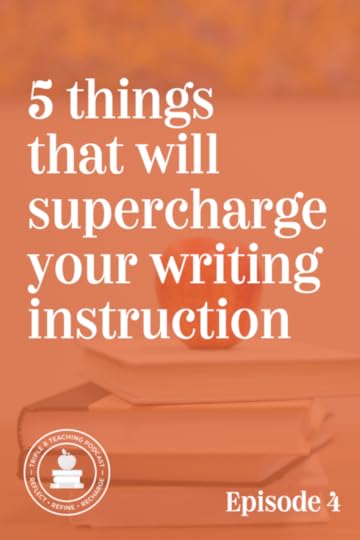
TRT Podcast#4: 5 Things that Will Supercharge Your Writing Instruction
Does your writing instruction need a boost? Doing these five things will make a BIG difference. When you implement them, writing time will be more fun (and productive) for both you and your learners.
Listen to the full episode
Full episode transcript
Hello, Anna here! I'm so glad you���ve joined me for episode 4: 5 things that will supercharge your writing instruction.
���This episode is brought to you by Teaching Every Writer, my online course for K-2 teachers and homeschoolers. Please visit teachingeverywriter.com to learn more.
���I���d like to start this episode with a quote from Welcome to Writing Workshop, a book by Stacey Shubitz and Lynne R. Dorfman: ���Writing is the most powerful tool we have to think aloud on paper, organize our thoughts, and make our thinking visible and permanent.���
���Let���s dive in right away into the 5 things you can do to supercharge your writing instruction.
���Number one: Have a dedicated, predictable time each day for your students to write independently.
This is true whether you teach kindergarten or eighth grade. It���s very important this is a block of time and not bits and pieces throughout the day.�� Sometimes we like to think, "Well my students do writing during Social Studies, they write during reading time, there are other subjects where we occasionally��integrate writing. I don't need a separate writing period." Just listen to yourself for a minute. You could never say that about Math, right? Or reading? "Oh, well you know, I sprinkle math all through the day here and there." Or "Well, we do reading in Social Studies, we read the instructions on our Math worksheet. We don't really need a reading period." Of course, not, right? That's ridiculous! The same is true for writing. Writing is a complicated thing. It requires instruction and practice���every day if you can, at a minimum three days a week. Not only do you need this dedicated writing time every day, it needs to be in one block. So, don't do ten minutes in the morning and ten minutes in the afternoon. Think of writing as a train moving down the track. It takes a lot of energy and "oomph" for that train to get started, but once it's going it's moving smoothly. It does take quite a bit of energy to stop the train, right? So if you have to keep restarting��and stopping the train, you're losing time.
Writing is the same way. It takes a lot of mental energy to get into writing and that���s why the writing block needs to be kind of long. It can't be fifteen minutes, because it could take ten minutes before your students' brains really start to flow and they start to actually get going.��
Think about the last time you did some writing. You know that it requires an intense amount of thought and mental clarity to write well. So, I recommend a forty to sixty minute writing period.��
Don���t worry, your students are not spending that whole period writing. You're going to start with a mini-lesson, about ten minutes. Then, you'll have the��period of twenty to forty��minutes��for them to write or draw, potentially, in kindergarten.��Then,��you'll conclude with about ten minutes of whole-class sharing time.
Believe me, I know how hard it is to schedule time for every subject area! You always feel like you have to rob��something from this subject or that subject to squeeze everything in. But try really hard not to make independent writing time too short. There was one year I tried to do that and boy, we just couldn't really get into writing that year I think my writing workshop was only a total of thirty minutes and it was just cutting it too close. My students really didn���t have enough time to get into their writing.��
Here's another quote from Shubitz��and��Dorfman, ���We cannot skimp on independent time because kids��need uninterrupted periods of time to hone their writing craft to��develop��the stamina and��endurance they need to be strong writers.�����
That's the first thing��you can do to supercharge your writing instruction: have a dedicated time each day that your students write. I recommend the writing workshop approach.��
The second thing you can do is ditch the writing prompts and give your students the gift of choice.
I know��it���s very easy to find and print writing prompts. You just put them at a center or you pass out a worksheet for everybody, or you put a prompt on the board and they write in their journal and it��can feel like that's the best way to teach writing.��Prompts have their occasional place, but a��steady��diet of writing prompts is not good for our students. They need to work through the whole��writing process and one thing writers do is find their own topics and ideas for writing. Our��students need to do the same.��
When we talk about giving our students choice as writers, there are three things I think about. We can give them choice as to genre, choice as to purpose or audience, and choice as to��topic. Much of the time, we're telling them what genre to write in. If you're doing a unit of study, for example��in first grade, it might be a unit on poetry and you expect all your students to be writing poems.��You may give them the purpose. It could be that you are having them write poems because they're going to be sharing them at a poetry reading for their parents in a month. But, when it comes to the topic, you wouldn't want to say "Everyone has to write a poem about flowers." Or, "Everyone has to write a poem about the color blue." This is where we want to give our students choice.��
If you think about this idea --"Wait, all of my students have to think of their own topics for writing?"--and that makes you squirm because you're afraid that during writing time all you're going to hear is "I don't know what to write about! What should I do?" Or you're picturing whole rows of children just sitting there, stumped, not knowing what to do���I hear you. I'm not going to lie, you will hear that from time to time --"I don't know what to write about!" But, the solution is not to hand out topics. It���s to teach your students to find their own topics, which is what real writers do every day.
���If any of you are parents, you have probably had a child or two who likes to tell you "I'm��bored. I have nothing to do." With six kids at home, I absolutely hear this a lot, and from one child in particular.��While I may offer a few ideas, they are usually all rejected, so I don't usually offer them. Mostly what I say is ���It���s not��my job to find things for you to do.��� I know this sounds a little harsh, but this forces him to solve this problem on his own, which he usually does.��
I���m not suggesting that when your students say "I don't know what to write about!" You respond by saying, ���It���s not my job to tell��you what to write��about.��� No, I don't suggest that. But, what you can do is��teach them HOW to decide what to write about.��
What you can do in some of your mini-lessons is, for example, give your students the chance to create an��expert list. Show them how to make a list of things they know a��lot about and could write something about. They could write about family members, vacations, places��they���ve been, things that are interesting to them. They could keep this piece of paper in their writing folder for future reference.
Instead of brainstorming major topics, you could have them��brainstorm times that they felt a particular emotion����� happy, excited, surprised.
As your students get older, so third grade and above, you could teach your students to use a writing notebook as a place to record writing ideas even when they're not at school, or at home if you're a homeschooler.��You may have seen this all over the place on the internet or Pinterest, where you have them draw a large heart on a piece of paper or you give them a printable with a large heart on it and in each section of the heart, they draw or write about things that are important to them. We call that a heart map��and that can provide a source of writing ideas for the future. You could invite your students to write a list of the ���ten best things��� that have ever happened to��them��or�����ten really good things,��� then have them star��items on that list that they could write more about. You can make a class chart��of ���things we can write about��� and add to it regularly.��
The point is, you're not feeding them with topics, but you're giving them tools to find��their own.��
On my blog I have a collection of��printables��that you can use to help your students find their own writing topics. This is free and I will include it in the show notes for this episode, which you'll be able to find at measuredmom.com/episode4.
������Moving on to tip number three, I want to start by saying that if you feel like many people do, that you��aren't a strong�� writer. That you aren't good enough at it to teach it, I want to put your mind at ease, because you have��hundreds of��co-teachers right in your classroom or homeschool. Even��professional��teachers of writing know they need help.
Here���s a quote from Katie Wood Ray, in her��book��Wondrous Words: ���I can���t help students to write well by myself. I need lots of help doing��this��teaching work and I have found that help on the shelves of my library���And day after day as��I��teach writing to many different students, I let writers like Georgia (Heard) and Gary Paulsen��and��Cynthia Rylant and Jane Yolen help me do the important work of teaching students to write��well."
���That brings us to tip number three, the third thing you can do to supercharge your writing instruction. That is: use mentor texts.��
A mentor text is any text that can be used as an example of good writing for writers. The point of a mentor text is that you are studying how the text is written and you're trying that in your own writing.
���It starts with reading like a writer, noticing how the author crafts the writing. What did��the��author do to draw you in at the beginning of the story?��How did the author make the writing resonate with you? So often you read a book and you think,��"Eh, that was okay. It wasn't great." Or, you read a book and you couldn't put it down, right?��Think to yourself, "What is it about this writing that drew me in? That made me want to finish this��book in one night?" Analyze it, think about it, because those are the types of things you're going��to teach your students to do.
Maybe the author began the text with��a��quote. Or started the novel by describing the setting in vivid detail. Maybe an author organized a nonfiction text in a way that the layout made it easy for you to follow along and learn from. Or, maybe the author drew you in to��the��story by sharing exactly how the characters felt.
These are just a few examples of the things that mentor texts can teach us. Mentor texts don���t have to be published books by professional writers. You don't have to find a mentor text for every single mini-lesson that you give. Sometimes the best mentor texts are what you are writing yourself or even what your students or former students have written. Student mentor texts are sometimes��called "exemplars" and they are wonderful because they can help children see an example of something they can do. Sometimes that's even better than a published mentor text because it's something they can aspire to; it's within their reach. It also builds up students whose writing you shared.
���You do not need a huge collection of mentor texts. Some teachers have just a very small list of mentor texts because they know they can teach multiple things from each one. In fact, I have a collection of favorite mentor texts on my blog. It's a list of ten of the best mentor texts for teaching writing in K-2, because each one can teach multiple things. I will be sure to provide a link to that as well in the show notes.��
���Let's move on to the fourth thing you can do that will super charge your writing instruction, and that is to be a writer yourself.
I recently read an article on the Atlantic by Cindy O���Donnell-Allen. She wrote, "The best writing teachers are writers themselves. Why? Because we know��the��writing��process inside out, we can support our students��� work in authentic ways."
���I love to write, but I do not find it effortless. I don���t even find it easy. It���s some of��the��most��challenging mental work that I do, but it's so rewarding. I encourage you to find times to write. It's going to look different for everybody. Personally, I don't keep a journal, I don't keep a diary, I don't keep a writing notebook where I observe things in the world, but you may want to do that. My writing mostly comes in the form of writing scripts for these podcasts, or writing blog posts, or creating video trainings for The Measured Mom Plus!��
You need to write on your own so that you have experience writing what you expect your students to write. If I would be teaching a unit on poetry, I would want to spend a little bit of time writing poems on my own, even if that's not my favorite genre.��If I were teaching my students to write a personal narrative, I would want to spend some��time writing about some memories from my childhood.��
I know, I know, you are busy and you probably don't like the idea of setting aside time to write, but put it on your calendar. Just set a timer for twenty minutes and make yourself get started. You will see a few things: that you have stops and starts as you think and reread. This is what you can expect��to��see��when��your students write. You will find that some days, writing will come naturally. Other days you will struggle to get your��thoughts��onto paper.��This is what you can expect when your students write. Above all, you will become a stronger writer with consistent practice. This is what you can��expect��when��your��students write.
���Not only should you make it a priority to spend just a little bit of time writing��by��yourself outside the classroom,��please, please,��please��WRITE IN FRONT OF YOUR STUDENTS. Compose in front of your students during your mini-lessons. Try not to have everything planned out in advance. Let your students see you think about what topic you're going to write about. Let them see you struggle as you think of how to begin and how to continue and how to end. They need to see, in real life, that writing is messy, even for grown-ups.����
���Thing number five: talk with your students about [their] writing.
During independent writing time when all your students are writing, you are either giving small-group writing conferences or moving around the classroom conferring with individuals one-on-one.��There��are so many benefits to speaking with children individually about their writing, and I promise you there is��no��better way to get to know them��as writers and as people. This is a wonderful thing to do in the classroom or the homeschool. I promise you, it will bring you closer to your students or your children. It's the chance to give them exactly what they need to learn, because you are tailoring your teaching to the individual child.��
���The purpose of a writing conference��is to move a writer forward, not to make a��particular��piece��of��writing perfect. It's very easy to lose sight of that, especially when we look at a piece of writing and all the errors are just jumping right out at us���all the spelling, all the grammar, or the fact that it doesn't really make sense. We can pick one thing��to focus on, one thing in a conference and it needs to be one thing that this writer can use on the next piece they write, and the piece after that, because remember, we're moving the writer forward, not perfecting a piece of writing.��
���As you sit with a student to talk about his or her writing, there are many things you can do. It might be you're just helping a particular writer get started, to move past that initial writer's block. You might be providing feedback, so maybe a child is ready to move into revising or editing and they want to know what you think of their writing. You might identify a problem the two of you can work on together.
Maybe the writer is writing something that doesn���t flow well. Maybe it doesn���t have a lot of focus, and there's a lot of different things and it's hard to follow. You could teach them something that will improve the structure of their writing, maybe something about spelling, or grammar, or��punctuation. You could set writing goals with the writer.��
���This idea of writing conferences is a big one. Many books have been written just about this, which is why in a few weeks I���ll have a podcast all about��how��to��give��strong��writing conferences.
���For now, let���s just recap those five things you can do to supercharge your writing instruction.
Number one, have a dedicated, predictable time each day for your students to write independently.��Number two, ditch the writing prompts, and give your students the gift of choice. Three, use mentor texts. Four, be a writer yourself. And five, talk to your students one-on-one about their writing.
I have a lot to share with you in the show notes for this episode. I'm going to give you the link to my online course, teachingeverywriter.com which is perfect for teachers and homeschoolers of kindergarten, first and second grade. I co-created that course with my colleague, Becky Spence, of This Reading Mama.
���You'll also find a link to my��e-book, How to Help Kids Learn to Write and Love It,��which��is��for��teaching writing in K-8. I would say that e-book is not necessary if you're a member of the course, but it's great for third grade and up, since my course is for K-2.
���Finally, I���ll share some links to some blog posts including that��post��with��the��free��printables��for��helping students find their own writing ideas, as well as the��link to ten of��the��best��mentor texts for��teaching writing. You can find all of those at themeasuredmom.com/episode4.
���Thanks so much for listening, and I���ll talk to you again next week!��
+ Click to view entire transcript
- Click to collapse
Related resources
Teaching Every Writer, my online course for teaching writing in K-2. Learn more here.
Blog posts
How to help learners find their own writing ideas
The best mentor texts for teaching narrative writing in K-2
Quoted resources
The Best Writing Teachers Are Writers Themselves , by Cindy O’Donnell-Allen
Wondrous Words , by Katie Wood Ray
Welcome to Writing Workshop , by Stacey Shubitz & Lynne R. Dorfman
Resources for members of The Measured Mom Plus
Quick video training: How to get started with writing workshop in K-2
Printables for teaching writing
Subscribe & review in iTunes
Are you subscribed to my podcast? If you���re not, I want to encourage you to do that today. I don���t want you to miss an episode!�� Click here to subscribe in iTunes!
Now if you have an extra minute, I would be really grateful if you left me a review over on iTunes , too. Those reviews help other people find my podcast, and they���re also fun for me to go in and read. Just click here to review. You’ll need to click to “Listen on Apple Podcasts” and “write a review.”�� Let me know what you appreciate about the podcast. Thank you!
There are many ways to listen …
Subscribe in iTunes
Subscribe in Spotify��
Subscribe in Stitcher
Looking for the entire podcast library?
Click here to see all episodes.
© 2020, Anna G. All rights reserved.
The post 5 Things that will supercharge your writing instruction appeared first on The Measured Mom.
Check out this limited-time bonus for new members!
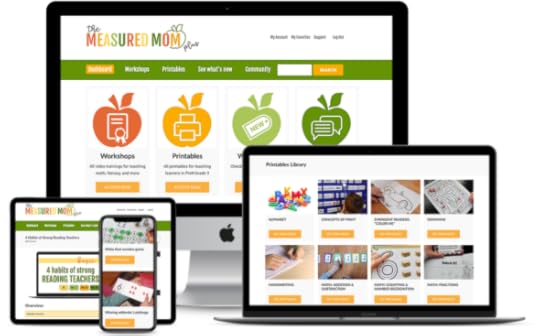
You’re invited to join The Measured Mom Plus, my affordable membership site for PreK-grade 3 educators.
When you join, get immediate access to on-demand video workshops and mini-courses that you can watch 25/7. (You can even print certificates of completion!)
Get immediate access to hundreds of engaging student printables, with new math and literacy resources each month.
Ask questions, get advice, and submit requests for future trainings and printables in our private Facebook group.
Join by Sunday, March 1, and get a special bonus!
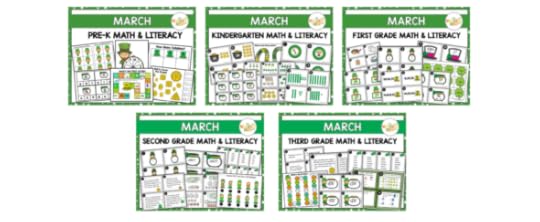
All current members – and everyone who joins by Sunday, March 1, will also get these bonus seasonal packs… for free! Each pack contains 20 math and literacy activities for a particular grade level.
Get a quick walk-through in the video below …
For more information, including current pricing details, please visit this page.
© 2020, Anna G. All rights reserved.
The post Check out this limited-time bonus for new members! appeared first on The Measured Mom.
February 16, 2020
10 Tips for teaching writing in kindergarten
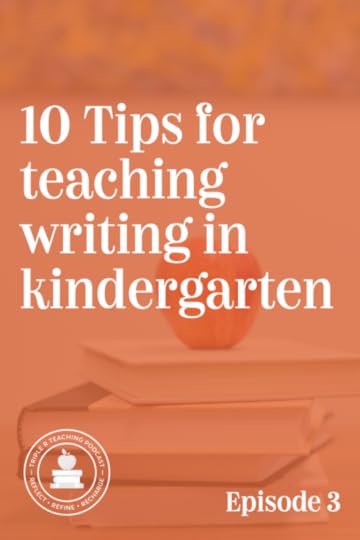
TRT Podcast#3: 10 Tips for teaching writing in kindergarten
Do you have questions about teaching writing in kindergarten? In this podcast episode I’ll give you my top tips for helping young children become strong writers.
Learn the ideal structure for teaching writing.
Discover how to help your students find their own ideas.
Find out how to set high expectations while celebrating what your students can do as writers.
Learn what to do about spelling, and more!
Click the play button to listen
Remember that you can hover over the player to speed up or slow down the audio.
Related resources
Teaching Every Writer, my online course for teaching writing in K-2. Learn more here.
Teaching Every Writer sneak peek video series
What to teach writers in K-2.
How to get kids actually interested in writing
Tips for getting your writing workshop started .
How to help students move from drawing to writing
The secret to meeting every writer’s needs
How to each young writers to spell on their own
Tips for managing writing workshop .
Mentor texts for teaching writing in K-2
How to teach revising and editing in K-2
Why sharing time is worth it
Resources for members of The Measured Mom Plus
Quick video training: How to get started with writing workshop in K-2
Printables for teaching writing
Subscribe & review in iTunes
Are you subscribed to my podcast? If you���re not, I want to encourage you to do that today. I don���t want you to miss an episode!�� Click here to subscribe in iTunes!
Now if you have an extra minute, I would be really grateful if you left me a review over on iTunes , too. Those reviews help other people find my podcast, and they���re also fun for me to go in and read. Just click here to review. You’ll need to click to “Listen on Apple Podcasts” and “write a review.”�� Let me know what you appreciate about the podcast. Thank you!
There are many ways to listen …
Subscribe in iTunes
Subscribe in Spotify��
Subscribe in Stitcher
No time to listen? Read it instead!
Download a transcript
Looking for the entire podcast library?
Click here to see all episodes.
© 2020, Anna G. All rights reserved.
The post 10 Tips for teaching writing in kindergarten appeared first on The Measured Mom.
Free main idea passages: task cards!
Finding the main idea isn’t always the most fun skill to practice – but your students will love the engaging main idea passages on this set of free task cards!
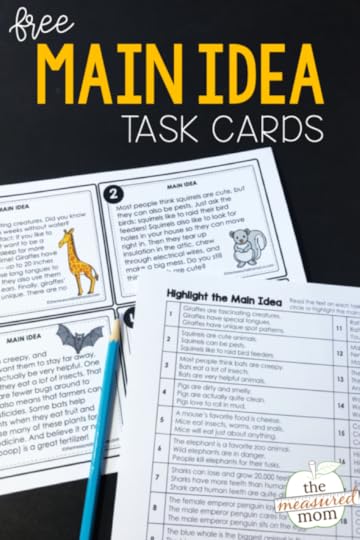
Main idea has got to be one of the most difficult reading skills to teach.
But it’s��oh, so important.
We want our readers to be able to understand the “big idea” from a text.
What do they need to remember?
What is essential and what is nonessential?
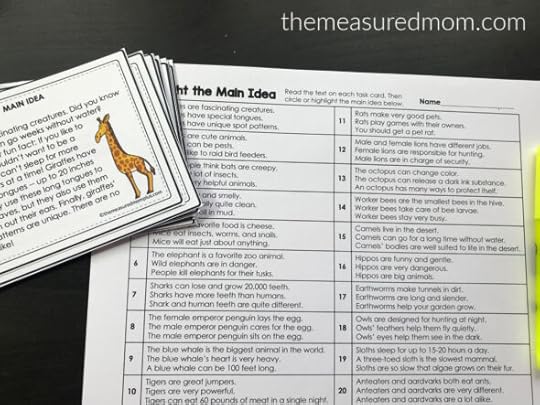
Main idea is definitely a tricky concept to teach, so I made these main idea task cards for members of The Measured Mom Plus. And today I’m sharing the file with you … for free!
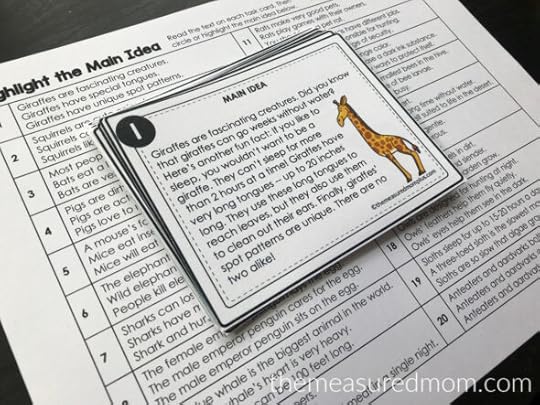
The file comes with 24 task cards. Each card has an engaging passage about a particular animal.
When I used the activity with my second grader, we used the simpler answer sheet.

After reading each task card, he chose the main idea from the three choices on the answer sheet.
I helped him see that, sometimes, the main idea is directly stated in the paragraph.
Other times, we need to infer the main idea based on the details.

My fourth grader (who informed me that he has a hard time with main idea), had the more difficult task. Instead of choosing from a list of main ideas, he had to write them on his own.
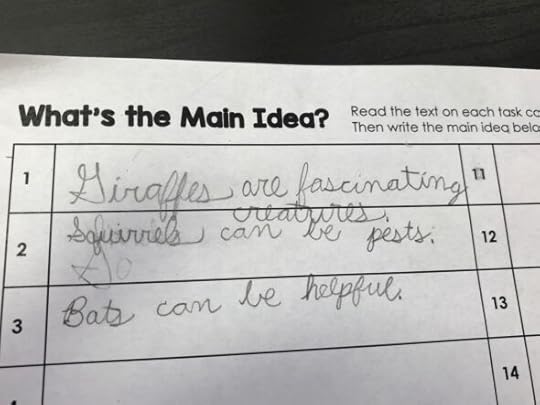
We worked on this together, and finding the main idea wasn’t easy for him.
He often came up with a main idea that was much too specific. Together we looked at the sentences in the paragraph to make sure they all supported his main idea. If not, we knew we needed something different.
Here are some tips for teaching main idea:
Reminder your learners that they are looking for the “big idea” that the text is about.
The details should point to the main idea. After a learner has named the main idea (whether correct or incorrect), ask more questions. “What are the details which support that main idea?”
Sometimes learners can get too specific with the main idea; help them see that a main idea is more of a general statement.
Teach your learners that the main idea��may or may not be explicitly stated as a topic sentence. This sentence can be anywhere within the paragraph.
When looking for the main idea, learners can ask themselves:
What’s important here?
What big idea does the author want me to remember?
What is the most important point about the topic?
I hope you enjoy these free task cards!
Get more reading comprehension activities
in The Measured Mom Plus!
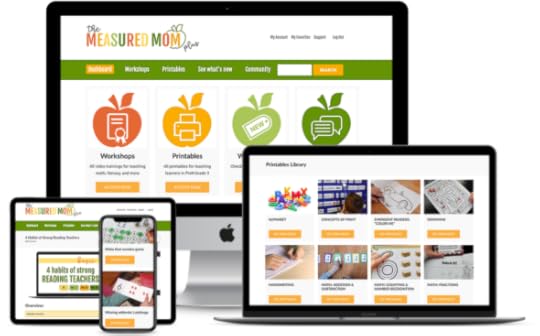
Get one-click access to hundreds of printables, including
Cause and effect task cards
Reading comprehension passages
Inference passages and task cards
Predicting task cards
Visualizing task cards
Compare and contrast task cards
with loads of new printables added every month!
© 2020, Anna G. All rights reserved.
The post Free main idea passages: task cards! appeared first on The Measured Mom.
February 10, 2020
Answers to YOUR questions about shared reading
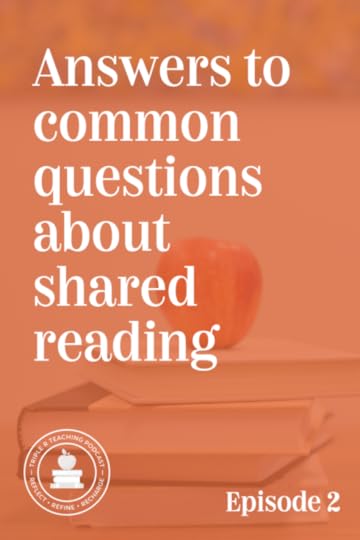
TRT Podcast#2: Answers to common questions about shared reading
In this episode I share answers to questions my readers have asked about shared reading.
What’s the point of shared reading?
How do I schedule shared reading?
Can I do shared reading with small groups or one-on-one?
How do I choose shared reading texts?
How do I keep my students engaged and paying attention during a shared reading lesson?
What do you do when you have students whose reading levels are way above the rest of the group?
Scroll down to get FREE 5-day shared reading lesson plans!
Click the play button to listen
Remember that you can hover over the player to speed up or slow down the audio.
Links mentioned in this episode
Shared reading blog series
Membership training: How to do shared reading in K-2
Membership printables: Shared reading 5-day lesson plans
Episode freebie

Subscribe & review in iTunes
Are you subscribed to my podcast? If you���re not, I want to encourage you to do that today. I don���t want you to miss an episode!�� Click here to subscribe in iTunes!
Now if you have an extra minute, I would be really grateful if you left me a review over on iTunes , too. Those reviews help other people find my podcast, and they���re also fun for me to go in and read. Just click here to review. You’ll need to click to “Listen on Apple Podcasts” and “write a review.”�� Let me know what you appreciate about the podcast. Thank you!
There are many ways to listen …
Subscribe in iTunes
Subscribe in Spotify��
Subscribe in Stitcher
No time to listen? Read it instead!
Download a transcript
Looking for the entire podcast library?
Click here to see all episodes.
© 2020, Anna G. All rights reserved.
The post Answers to YOUR questions about shared reading appeared first on The Measured Mom.
Anna Geiger's Blog
- Anna Geiger's profile
- 1 follower




